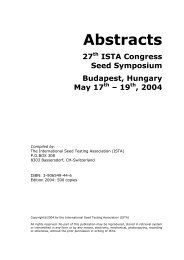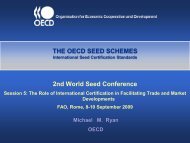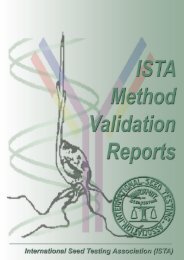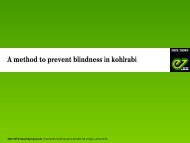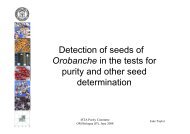Historical Paper - Volume 2 2008 - International Seed Testing ...
Historical Paper - Volume 2 2008 - International Seed Testing ...
Historical Paper - Volume 2 2008 - International Seed Testing ...
You also want an ePaper? Increase the reach of your titles
YUMPU automatically turns print PDFs into web optimized ePapers that Google loves.
H.A. JENSEN<br />
<strong>Seed</strong>s of Cuscuta spp. and Orobanche elatior turn yellow after treatment with a 0.1 N<br />
solution of soda-lye whereas no colour reaction was found in a similar test of more than<br />
100 other weed species (Grosbüsch 1948).<br />
The phenol reaction (ISTA Rules 8.8.1) was used for separating seeds of Vicia lutea<br />
and Vicia striata (Germ 1937) and for identification of the Merion variety of Poa pratensis<br />
(see 5.9.1). Schuphan (1948) and Papp (1973) used a spectral photometric method for<br />
identification of species and varieties of the genus Brassica.<br />
Vieritz (1992) used gel electrophoresis as an aid when distinguishing seeds of four<br />
species of Sida.<br />
Surveys on the rapid chemical identification techniques used in the ISTA laboratories<br />
have been published by van der Burg and van Zwol (1991) and in the ISTA Variety<br />
<strong>Testing</strong> Handbook (ed. Payne 1993).<br />
References to other papers, describing the use of chemical methods in seed<br />
identification, can be found in Jensen (1998b).<br />
The fluorescence method for separating Lolium perenne and L. multiflorum has, as<br />
indicated above, been commonly used. Other chemical analysis has only been rarely used,<br />
as the number of seeds available in most cases was limited and the methods described<br />
frequently required specific equipment and chemicals.<br />
9. Relation to other ISTA Committees<br />
9.1 Bulking and Sampling Committee<br />
9.1.1 Dividers<br />
Representative and correct working samples have been the responsibility of the Bulking<br />
and Sampling Committee since the creation of this committee. The subject has been<br />
an important item for the Purity Committee as well, because the accuracy of both the<br />
purity analysis and determination of other seeds by number are strongly influenced by the<br />
dividing method.<br />
Thomson and Doyle (1955) compared the halving and the random cups methods for<br />
Lolium perenne, L. multiflorum, Trifolium pratense, T. repens, Brassica spp. and Lactuca<br />
sativa. The variation between duplicate samples was not significantly different for the two<br />
dividing methods.<br />
Madsen and Olesen (1962) compared working samples obtained by means of a spoon<br />
and by a Pascall divider. The variation in the purity results after sampling by the divider<br />
was far greater than the corresponding variations after sampling by the spoon method.<br />
The experimental work with this divider was discontinued, as comprehensive unpublished<br />
experiments with the Boener divider demonstrated that this divider gave more reliable<br />
results. Accordingly, since 1969 the Boener divider replaced the hand method for drawing<br />
working samples at the Danish State <strong>Seed</strong> <strong>Testing</strong> Station.<br />
Warwick (1978) compared five methods: random cups, centrifugal divider and three<br />
types of soil divider with varying number and widths of channels for obtaining working<br />
samples from submitted samples. The optimum results of the dividing depended on the<br />
size of the seeds used.<br />
30



